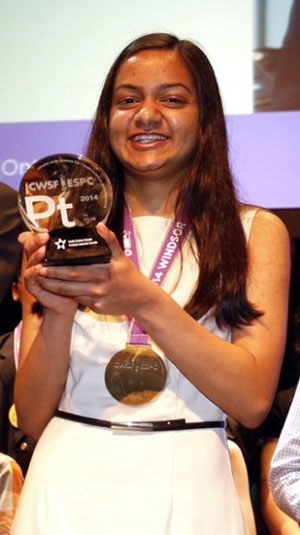
May 27, 2014
Ten.
That’s how many iterations 15-year-old Maya Burhanpurkar went through when she designed an experimental apparatus to demonstrate a previously elusive physics concept, winning the Platinum Award at last week’s Canada-Wide Science Fair for her project titled “The Time-Integral of Distance: Uncovering A New Property of Fundamental Physics.”
Burhanpurkar’s work was mentored by Professor Steve Mann and PhD student Ryan Janzen, both of The Edward S. Rogers Sr. Department of Electrical & Computer Engineering, in collaboration with Dr. Brad Bass of Environment Canada and the International Panel on Climate Change.
Professor Mann coined the term “absement” to describe the time-integral of distance, historically an elusive concept. Since the days of Sir Issac Newton, we have known that the time-integral of acceleration is velocity (shown by the formula a=Δv/Δt), and the time-integral of velocity is distance (v=Δd/Δt), yet the time-integral of distance has remained an elusive concept. This is the first time the change in distance over time had been demonstrated in physical space.
“Professor Mann had been thinking about the possible influence of the time integral of displacement in nature, mostly music, for a few years already,” said Burhanpurkar. “I came up with the design of a novel experimental apparatus consisting of a fluid reservoir with a microprocessor-controlled, linear valve whose motion resulted in the precisely controlled release of fluid at continuously varying, pre-programmed rates.
“I built about ten iterations of the device before finally getting it right.”
Burhanpurkar took top honours at last year’s Google International Science Fair last year with the same project, but winning at this event was still a thrill. “I was beyond excited!” she said. “I had won the Grand Platinum award a couple of years ago at the national science fair, so I was really surprised to be given it again.” She also brought home several category awards including the Discovery Challenge Award, the Actuarial Foundation of Canada Award, a Gold Medal and university scholarships.
The group met with Burhanpurkar several times to discuss the project design in advance of the fair. She and Janzen spoke frequently, especially as she picked up the calculus necessary for the work. Their next goal is to get the work published.
“We’re happily continuing to work with Maya as well as some new students, and would welcome any additional highly gifted students, to apply absement to other areas of biology, physics, ecology and medicine,” said Janzen.
Watch Burhanpurkar’s recent invited talk at TEDxYouth@Brampton.
More information:
Marit Mitchell
Senior Communications Officer
The Edward S. Rogers Sr. Department of Electrical & Computer Engineering
416-978-7997; marit.mitchell@utoronto.ca